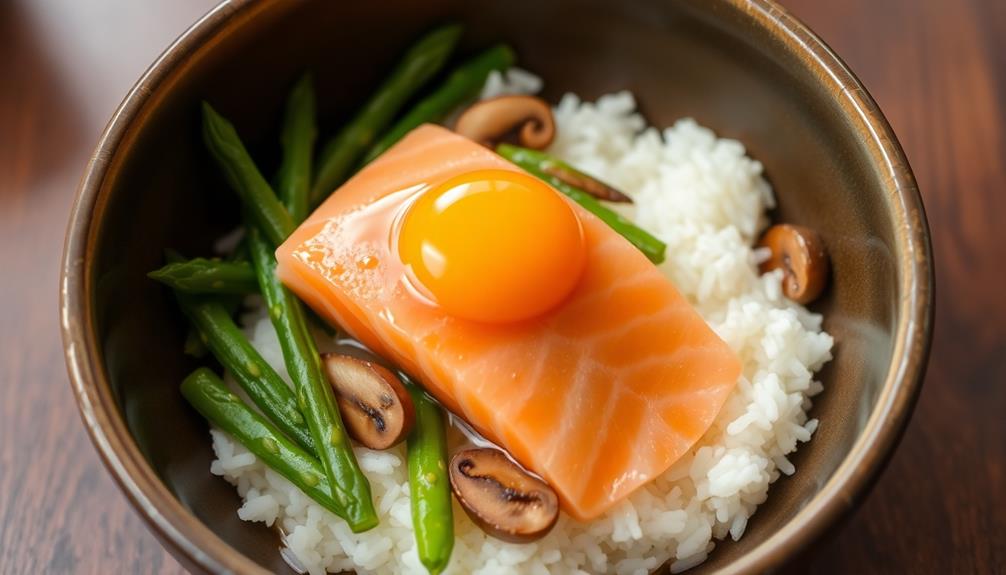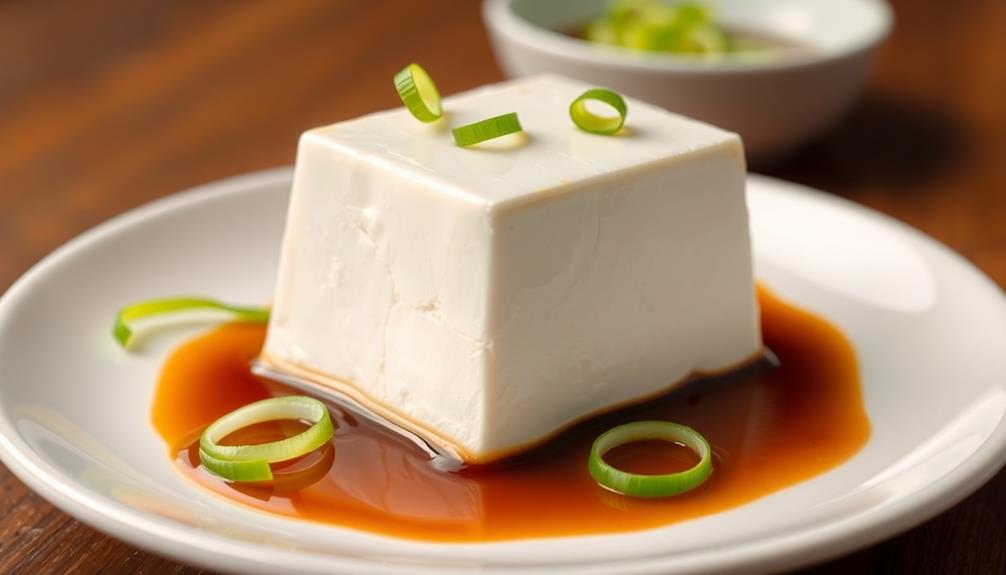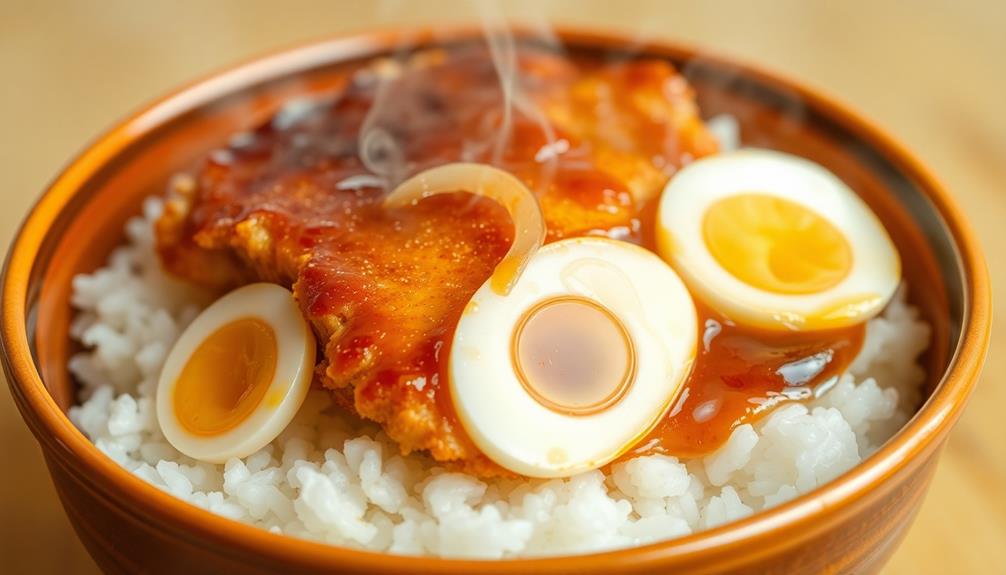The secret to crispy tempura lies in achieving the perfect batter viscosity. You want your batter to be light, thin, and coat ingredients evenly without being too runny or thick. Using cold water and adjusting gradually helps you attain this ideal consistency. A well-balanced batter ensures the coating stays crisp and light during frying, while the right oil temperature helps lock in that crunch. Keep exploring this balance to master that irresistible tempura crunch.
Key Takeaways
- Achieve a light, coat-like batter by gradually adding cold water to control viscosity.
- Maintain the batter slightly thinner than pancake batter but thicker than soup for optimal crispiness.
- Use cold water to keep batter airy and prevent it from becoming heavy or greasy.
- Proper oil temperature (340°F–360°F) ensures the batter crisps quickly without absorbing excess oil.
- Consistently test and adjust batter thickness to ensure even coating and delicate crunch.

If you want your tempura to be irresistibly crispy and light, mastering the perfect batter is fundamental. The secret to achieving that delicate, airy crunch lies in controlling the batter’s viscosity. It’s not just about mixing ingredients; it’s about understanding how the batter’s thickness influences the final texture. When your batter has the right viscosity, it clings just enough to the ingredients without becoming heavy or greasy, guaranteeing each piece turns out perfectly crisp.
First, pay close attention to your batter ingredients. Typically, a simple combination of cold water, all-purpose flour, and a touch of cornstarch or rice flour works best. The key is to keep the batter light and slightly runny, but not too thin. Using cold water is essential because it helps create a batter with a lower viscosity, leading to a crispier finish. If your batter becomes too thick, it will coat your ingredients heavily, resulting in a dense, chewy texture instead of light and crispy. Conversely, if it’s too thin, it won’t adhere properly, causing uneven cooking. Adjust your batter’s consistency by adding water a little at a time, testing the flow to guarantee it’s just coat-like—thinner than pancake batter but not as watery as soup. An understanding of batter viscosity can help you troubleshoot and achieve consistent results every time. Incorporating proper batter consistency techniques is essential for optimal results. Additionally, controlling ingredient freshness can influence how well the batter adheres and crisps up.
Use cold water and adjust gradually for a light, crispy tempura batter.
Another critical factor is oil temperature. Maintaining the right oil temperature—around 340°F to 360°F—is indispensable for crispiness. When the oil is too cold, the batter absorbs excess oil, turning soggy rather than crispy. When it’s too hot, the batter can burn before the interior cooks. Proper oil temperature ensures rapid evaporation of moisture from the batter’s surface, creating that iconic crunch. When your batter has the right viscosity, and your oil stays within that ideal temperature range, you’ll notice the tempura floats gently and crisps evenly.
The viscosity also affects how the batter interacts with the oil. A batter that’s too thick clings too heavily, resulting in a greasy bite. When it’s just right, it forms a light, airy coating that crisps perfectly. The secret is to keep your batter cold and slightly runny, and your oil at the proper temperature. Practice makes perfect—adjust your ingredients and temperature gradually, and you’ll find the sweet spot that produces tempura with that coveted crispy, delicate texture. When all these elements come together, your tempura will stand out for its irresistible crunch and tender interior. Additionally, understanding the role of batter viscosity can help you troubleshoot and achieve consistent results every time.
Frequently Asked Questions
Can I Reuse Tempura Batter for Multiple Batches?
You might wonder if you can reuse tempura batter for multiple batches. While reusing batter can save time, it risks compromising batter freshness and reuse safety. As batter sits, it absorbs moisture and air, reducing crispiness and increasing bacteria growth. To guarantee the best texture and safety, it’s better to make fresh batter each time. Reusing batter isn’t recommended if you want consistently crispy, safe tempura.
What Types of Oil Are Best for Frying Tempura?
Think of frying tempura like sailing—using the right wind makes all the difference. For best results, choose oils with high smoke points, like peanut, canola, or rice bran oil, to prevent smoking and guarantee crispiness. These oils also have better health considerations, reducing harmful compounds. Avoid low smoke point oils like olive or butter, which can break down quickly and compromise flavor and safety.
How Do I Prevent Batter From Becoming Too Thick?
To prevent batter from becoming too thick, focus on maintaining the right batter consistency. Use cold water and add it gradually to your flour, mixing gently with a light folding motion. Avoid overmixing, which can cause clumping. Stick to proper mixing techniques, ensuring the batter stays thin and smooth. If it thickens, just add a little more cold water until you reach the ideal, runny consistency for crispy tempura.
Is Gluten-Free Flour Suitable for Tempura Batter?
Yes, gluten-free flour can be suitable for tempura batter, especially if you’re avoiding gluten or have allergen considerations. You can experiment with gluten substitutes like rice flour, sweet rice flour, or cornstarch to achieve a light, crispy texture. Keep in mind, the batter might behave slightly differently than traditional wheat flour, so adjusting liquid ratios may be necessary to get the perfect consistency.
How Long Can Prepared Batter Be Stored Safely?
Think of batter freshness as a delicate bloom that fades over time. You can store tempura batter in the fridge for up to 24 hours, but its quality diminishes with each passing moment. After that, it risks losing its crispiness and becoming less effective. To guarantee the best tempura, use your batter within this storage duration, keeping it chilled and covered to preserve its ideal viscosity and flavor.
Conclusion
Now that you know the secret to perfectly crispy tempura, you’ll never settle for soggy batter again. Keep the batter’s viscosity just right, and you’ll achieve a crunch so divine, it’s practically a symphony of crackles with every bite. Your tempura will transform into a golden, irresistible masterpiece—so light and crispy, it might just defy the laws of physics! Get ready to impress everyone with your newfound mastery and elevate your tempura game to legendary status.









